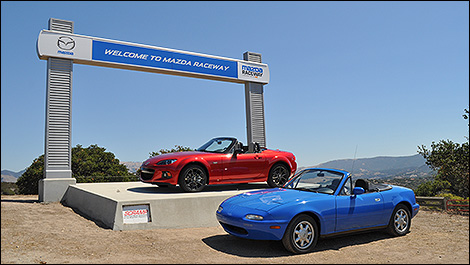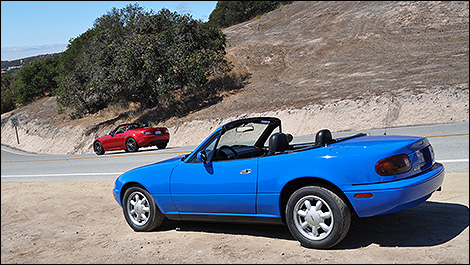Sep
17th
Stay connected Subscribe to our RSS feed
There are countless automotive stories out there that deserve to be told. The Mustang and the birth of the pony car; the Corvair and the disaster it was; the Beetle; the Model T are but some very famous examples. All have their place in automobiledom and their stories will be shared for centuries to come.
One such story is the one that stars Mazda's MX-5 Miata. First, know that the MX-5 celebrated its 25th Anniversary on February 10, 2014, and that it is the bestselling two-seat roadster of all time, with more than 930,000 on the road around the world since it first became available in 1989. This is a Guinness World record that is likely to stand for a very long time.
Mazda is clearly proud of its Miata, and with good reason. The story behind the MX-5 is a cool one and it begins with a suggestion that was made by an ex-motoring journalist, Bob Hall. In 1979, he got the idea for a 2-seater roadster based on ye olde British roadster. There's a famous picture of a blackboard drawing that is the earliest known rendering of what was to become the Miata. It's also a reminder to Bob as to why he's not a car designer...
Mr. Hall was offered a job at Mazda and has since been regarded as the "biological father" of the MX-5/Miata. Although not an engineer (or designer), Mr. Hall knew what the MX-5 was to be, and that was something specific, he also knew what it was not to be.
The birth of the icon
As you might expect, the final NA Miata that we know and love did not start off that way. Many versions, iterations, and interpretations were created as the design evolved. Most of these early exercises lacked a statement of the moment attraction/appeal. It initially lost an internal concept competition, but Mr. Hall's team was thankfully given a second chance.
While the Miata was coming together, many potential names were thrown around including the 1600S and Laguna. The name Miata means “reward” in old German and it would seem that the way the word sounded is what got Mazda to select it as the car's name.
Tom Matano was charged with bringing Mr. Hall's idea to life. His job was, in part, to make the MX-5 Miata discovery process a fulfilling and exploratory experience. As he put it, from that first turn of the wheel, the car must grab you, make you forget what you're driving and leave you with the feeling that all you want is more.
The definition of “fun to drive”
In more concrete terms, the then-new 1st generation Miata wasn't going to be a flamboyant display of styling, power or record-breaking performance. The MX-5's concept was to be compact, fun-to-drive, easy to live with, lightweight and many other things that true driving enthusiasts crave.
Kansei engineering (emotional/affective engineering) is what this is. This focus on emotional values rather than performance -- fun and beauty over raw power and big specs -- was the point. Needless to say, at this point Bob and Tom were on the ball given the small roadster's smashing success. In fact, the Miata set the tone for the company's future credo. Have you ever heard of Zoom-Zoom? Its existence is a direct result of the Miata's existence.
Racecar? You betcha!
The NA Miata was but an infant and already those in the know were envisioning a car that would see track time. The only explanation for this prediction was the presence of a crystal ball, as the MX-5 is the most road-raced car in the world. The world.
This is the reason why Mazda continues to embrace the sports car in its purest form. It must be fun to drive and, very importantly, affordable. These factors have ensured longevity and second lives (or more) for almost every MX-5, and from every generation.
Generations
The 1st generation NA MX-5 Miata launched in July 1989, a few short months after production began in April of that year. The NA carried on until the NB arrived in 1998. The NC (or current Miata) landed for the 2006 MY in the summer of 2005.
The world received its first sneak peek of the fourth generation of the car on April 16, 2014 when Mazda introduced details on the new chassis at the 2014 New York Auto Show. We now know what the car will look like, but technical details on the ND have yet to be released.
One such story is the one that stars Mazda's MX-5 Miata. First, know that the MX-5 celebrated its 25th Anniversary on February 10, 2014, and that it is the bestselling two-seat roadster of all time, with more than 930,000 on the road around the world since it first became available in 1989. This is a Guinness World record that is likely to stand for a very long time.
Mazda is clearly proud of its Miata, and with good reason. The story behind the MX-5 is a cool one and it begins with a suggestion that was made by an ex-motoring journalist, Bob Hall. In 1979, he got the idea for a 2-seater roadster based on ye olde British roadster. There's a famous picture of a blackboard drawing that is the earliest known rendering of what was to become the Miata. It's also a reminder to Bob as to why he's not a car designer...
Mr. Hall was offered a job at Mazda and has since been regarded as the "biological father" of the MX-5/Miata. Although not an engineer (or designer), Mr. Hall knew what the MX-5 was to be, and that was something specific, he also knew what it was not to be.
 |
| Photo: Mathieu St-Pierre |
The birth of the icon
As you might expect, the final NA Miata that we know and love did not start off that way. Many versions, iterations, and interpretations were created as the design evolved. Most of these early exercises lacked a statement of the moment attraction/appeal. It initially lost an internal concept competition, but Mr. Hall's team was thankfully given a second chance.
While the Miata was coming together, many potential names were thrown around including the 1600S and Laguna. The name Miata means “reward” in old German and it would seem that the way the word sounded is what got Mazda to select it as the car's name.
Tom Matano was charged with bringing Mr. Hall's idea to life. His job was, in part, to make the MX-5 Miata discovery process a fulfilling and exploratory experience. As he put it, from that first turn of the wheel, the car must grab you, make you forget what you're driving and leave you with the feeling that all you want is more.
The definition of “fun to drive”
In more concrete terms, the then-new 1st generation Miata wasn't going to be a flamboyant display of styling, power or record-breaking performance. The MX-5's concept was to be compact, fun-to-drive, easy to live with, lightweight and many other things that true driving enthusiasts crave.
Kansei engineering (emotional/affective engineering) is what this is. This focus on emotional values rather than performance -- fun and beauty over raw power and big specs -- was the point. Needless to say, at this point Bob and Tom were on the ball given the small roadster's smashing success. In fact, the Miata set the tone for the company's future credo. Have you ever heard of Zoom-Zoom? Its existence is a direct result of the Miata's existence.
 |
| Photo: Mathieu St-Pierre |
Racecar? You betcha!
The NA Miata was but an infant and already those in the know were envisioning a car that would see track time. The only explanation for this prediction was the presence of a crystal ball, as the MX-5 is the most road-raced car in the world. The world.
This is the reason why Mazda continues to embrace the sports car in its purest form. It must be fun to drive and, very importantly, affordable. These factors have ensured longevity and second lives (or more) for almost every MX-5, and from every generation.
Generations
The 1st generation NA MX-5 Miata launched in July 1989, a few short months after production began in April of that year. The NA carried on until the NB arrived in 1998. The NC (or current Miata) landed for the 2006 MY in the summer of 2005.
The world received its first sneak peek of the fourth generation of the car on April 16, 2014 when Mazda introduced details on the new chassis at the 2014 New York Auto Show. We now know what the car will look like, but technical details on the ND have yet to be released.
 The latest auto news, reviews, prices, product and vehicle releases.
The latest auto news, reviews, prices, product and vehicle releases.